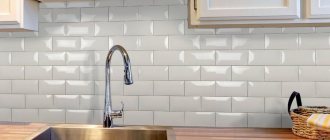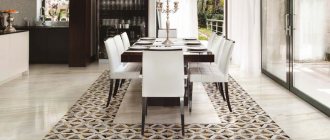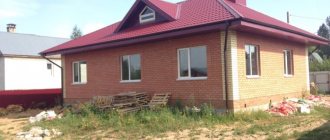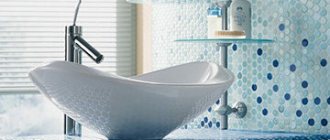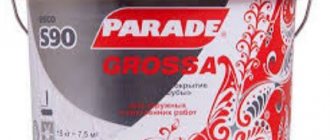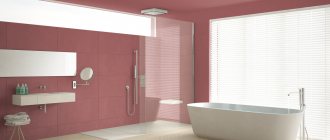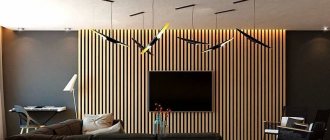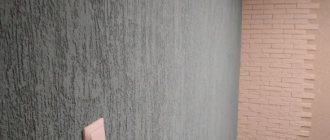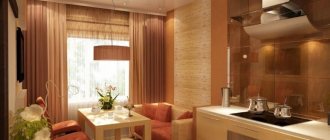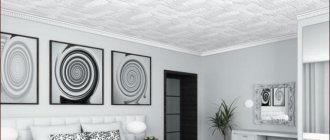Shopping › Online stores › Leroy Merlin
Go to Leroy Merlin
Leroy Merlin official website
Leroy Merlin is an online hypermarket of building materials, furnishings for an apartment, country mansion or country house. The international company offers a variety of products that allow you to arrange the life of a modern person with maximum comfort. The offers collected in the Leroymerlin Ru store make it easier for the user to search, eliminating the need to visit sales departments in search of building materials that are suitable in price and quality characteristics. It has become possible to improve your everyday life without leaving your usual stop, thanks to a company that sells materials and products of nine brands.
Pros and cons of use in the interior
Pieces of mirrors have long been used in interior decoration. Previously, a mosaic panel could be made from fragments of a broken mirror. Modern mosaics are made from particularly durable material. It has proven itself to be the best due to its features:
| Advantages | Flaws |
| It is resistant to abrasion and does not lose its shine over time. | If the mosaic is not fixed to the grid, but consists of individual parts, installation takes a lot of time and effort. |
| It is environmentally friendly, and is not afraid of moisture and aggressive detergents. | If a room decorated with mosaics is not ventilated, under the influence of moisture the canvas fogs up and darkens. |
| Strong and durable material, temperature changes do not affect it in any way. |
Practical advantages and disadvantages
As a material for cladding, mirrors are not much inferior to ceramic tiles or glass. This is a completely practical and very profitable solution, and from a design point of view it is suitable for any style.
The photo shows a Provence style kitchen with a mirrored apron.
Advantages:
- The basis of the mirror apron is tempered glass. This material is not afraid of temperature changes, steam, boiling water, or even open fire;
- The mirror surface has no pores, and, therefore, does not interact in any way with water, or with salts dissolved in it, or with dirt and soot. Even if drops and splashes are visible on the mirror, removing them, as numerous reviews confirm, will not be difficult: a damp sponge or glass detergent is enough;
- The mirror apron is resistant to all types of household chemicals. The only practically dangerous chemical for it is hydrofluoric acid, which is quite difficult to find in everyday life;
- the same applies to biological aggressors: neither mold, nor rot, nor fungus lingers on the glass. This material simply does not allow bacterial flora to multiply.
Flaws:
- In terms of strength, the mirror is inferior to ceramic tiles, although not by much: timely tempered glass is difficult to break even with a hammer;
- Do not use abrasive products for cleaning. This will not affect the practical properties of the mirror, but scratched or clouded glass will lose its attractive appearance.
Mirror mosaic finishing options
Mirror mosaic is a truly universal material. It looks great on any surface: walls, ceilings and even interior items - furniture, fireplaces, mirrors. Adding mirror strips or inserts to the decoration will help transform the space of the apartment. Installation of tiles attached to the mesh is easy: the canvas is glued to the prepared surface. The grout can be white or graphite in color.
Kitchen apron
Because of its advantages, a mirror panel is often installed in the kitchen as an apron. This decor not only expands the space, but also protects the wall from dirt in the cooking area.
Walls
The surface finished with mirror mosaic is very practical, so it can be tiled in any corner of the house: kitchen, bedroom, living room. This decor looks great in hallways and can also decorate a bathroom.
The photo shows a bathroom in a minimalist style. The interior is enlivened by a wall of combined mosaic tiles that form a pattern.
Ceiling
It is recommended to decorate part of the ceiling with mosaic tiles to avoid overcrowding the interior. The area where the chandelier hangs is successfully decorated: its mirror surface reflects light and casts picturesque reflections on the walls. The mosaic edging laid around the perimeter of the ceiling looks original - it increases the amount of daylight coming from the windows.
Wardrobe facade
You can decorate almost any furniture with mirror fragments: tables, cabinets, kitchen islands, bar counters. The façade of the wardrobe, decorated with mosaics, looks extraordinary.
The photo shows a wardrobe with a door decorated with mirror squares. Diagonal laying echoes the floor covering, and beveled edges make the interior richer.
Frame for a picture or mirror
Interior items decorated with mosaics always look stylish and original. You can make such a mirror with your own hands by gluing mosaic pieces to any surface.
Niche
A niche decorated with mini-mirrors will become the “highlight” of the interior, visually enlarging it and attracting the attention of guests.
The photo shows a fragment of a kitchen with a niche decorated with thin shiny stripes that visually deepen the space.
Fireplace
Mosaic is resistant to high temperatures and, despite its external fragility, is very durable. This coating is ideal for cladding a fireplace portal.
Laminate Artens “Kagiso” - installation features, quality assessment
Artens non-chamfered laminate flooring from the Egger factory was laid simultaneously in two rooms, perpendicular to each other and towards the light.
Artens panels are equipped with a 3G Just Clic locking connection, which allows the laminate to be laid in rows. Quite a strong simple lock, but with a high mounting angle. This inconvenience makes it difficult to install laminate flooring when there are doors. It was necessary to trim part of the lock to be able to close at a zero angle with the obligatory seating on glue. Also, dies with a Just clic lock are difficult to assemble in the opposite direction due to the short ridge part.
Just Clic Locking Connection
The flooring planks were assembled tightly; there were no steps either along the long part or at the end. Although this also occurs on more expensive laminates without chamfers. For some reason, in a number of packages, one of the boards was broken. I attribute this point to poor quality service for unloading goods.
The decorative film on the Artens “Kagiso” laminate seemed quite simple to me. But at a cost of about 600 rubles/m2, you shouldn’t expect anything special. An interesting point... when the sun came out of the window of one of the rooms at a low angle, it seemed that the laminate was defective. At the junction points, steps were formed. But I took a closer look and realized that the texture of the film still has bulges and casts a shadow, creating the effect of a bad joint between the planks. Nevertheless, for this reason, laminate with a beveled edge is more common.
The longest process involved installing the last rows of laminate under the door frame. After trimming the bottom of the box with a power chisel, we cut off the top of the back of the lock joint. This made it possible to insert the panel at a zero angle. Before installation, coat the cut part with Moment glue and clamp the boards together using a laminate staple.
Installing laminate flooring under door frames
Mosaic tile design ideas and shapes
Modern mosaic is represented by a wide range. Types of mirror tiles differ in the type of processing, shape, shades and size.
- The edges of products are processed in different ways: the surface can be ground or polished. A bevel is also used, which gives the tiles additional volume.
- On sale there are not only square-shaped products, but also in the form of rhombuses, rectangles, and hexagonal honeycombs. Round tiles are particularly original.
- To diversify the usual “silver” mirror shade, manufacturers have learned to tint products to look like black mirror, bronze and gold.
The photo shows a bathroom in which the space is uniquely expanded due to combined mirror parts of different sizes.
The mosaic also differs in its size: from small (10x10 mm) to large (several centimeters in area).
Assortment of construction and finishing materials
Visitors to the Leroy Merlin Roux hypermarket in Moscow, St. Petersburg or Rostov-on-Don, getting acquainted with the assortment, realize that they can improve their quality of life by arranging decent housing without financial expenses. It has become easy to organize comfort and coziness in your home; just check out the offers of Leroy Merlin, a leader in the global market. In the windows of Leroy Merlin, everyone can find the best offers to create the home of their dreams.
The clear interface of the official Leroymerlin Ru website, well-grouped products, timely online support from professionals - all this will help you quickly navigate the ocean of offers. Simple navigation helps you compare characteristics based on descriptions, customer reviews, and expert opinions. The official website consists of sections, including subcategories, which offer a variety of:
- Construction and finishing materials for major or cosmetic repairs (putties, primers, floor screed mixtures, heat-, hydro-, sound-proofing, roofing materials). An impressive selection will help you get the job done with dignity, no matter what stage the construction and renovation process is at.
- Carpentry and hardware (windows with window sills, stairs, entrance, interior, balcony doors, profiles for finishing work).
- Tools for processing wood, metal, plumbing equipment for professionals and beginners. Specialized construction tools for glass, tile, finishing, painting work.
- Storage systems for things and objects designed for maximum comfort. Modern dressing rooms or kitchen furniture are made from durable, environmentally friendly materials.
- Electrical goods, lighting fixtures (stylish table lamps, sconces, chandeliers, floor lamps, solar-powered street lighting systems, spotlights).
Each Leroy Merlin product name is represented by a photograph, which is accompanied by comprehensive information, including technical characteristics, dimensions, and cost.
Photos in the interior of the rooms
Mirror canvases have always added solemnity to the interior and expanded the space. Mosaic tiles look impressive, and most importantly, they provide ample opportunities for creativity: they can be combined with other materials, combine different sizes and shapes, and create shaped compositions.
In the kitchen
The mirror finish goes well with the chrome surfaces of the cookware. If the kitchen is combined with the living room, such an apron will become an additional decoration of the interior.
The photo shows a kitchen with a figured mosaic in the form of a hexagonal honeycomb.
In the bathroom and toilet
Small rooms will become wider and brighter if you decorate them with mosaics. Usually one wall or element of the bathroom is allocated for this: a countertop, a shower stall or an area where the mirror is located.
In the bedroom
A composition of mini-mirrors can be placed at the head of the bed or opposite the bed. In a small room, vertical panels would be appropriate. Thanks to this interesting technique, the bedroom can be made visually higher.
The photo shows a futuristic bedroom interior with an accent wall completely lined with mirror mosaic.
Laminate Artens "Kagiso" 33 class thickness 8 mm 1.986 m² - technical characteristics
- Weight - 14.44 kg
- Class - 33
- Width - 192 mm
- Length - 1292 mm
- Thickness - 8.0 mm
- Package quantity: 1,985 m2
- Number of dies per package: 8
- Purpose: Bedroom, Children's room, Living room, Kitchen, Corridor
- Compatible with low temperature floor heating (maximum 28⁰C) Yes
- Water resistance - No
- Chamfer - Without chamfer
- Color palette - White
- Surface Appearance - Structured
- Surface type - Light wood
- Impregnation of locks - Absent
- Main material: HDF
- Country of origin: Russia
- Fire safety class - (Russian standard) KM3
Dry statistics will not reveal anything; everything is beautifully described. In the next title I will tell you about the features of the Artens “Kagiso” laminate during the installation process.
In the corridor and hallway
The use of mosaics in the hallway is due not only to decorative considerations, but also to the small area of the premises. Furniture and panels with mosaic elements are appropriate in the corridor. And if you decorate a spacious hall with shining squares, this will favorably emphasize its royal size.
In the living room
The interior of the living room, decorated with mosaics, acquires a special charm.
The photo shows a living room decorated with stripes of mini-mirrors. Such illuminated architectural elements serve a decorative function, unifying the space.
How to make it yourself
If there is an unfilled area of any surface in your home, try to revive it yourself with a mirror mosaic made by yourself. You can involve the whole family, especially children, in this exciting process.
To do this, you will need an old mirror, which must be cut into pieces using a glass cutter. These can be fragments of different sizes and shapes - a matter of your taste and your imagination. The main thing is to fold them correctly to create a beautiful ornament.
Each piece should be sanded with an emery block. Sand the corners especially carefully so as not to injure yourself during the work. The result should be a lot of mirrored pieces with dull edges. To glue a homemade mosaic you will need several different tools:
- PVA glue or “liquid nails”. The latter are better, because they will not let it break;
- putty;
- plasticine.
In addition, you will need latex putty, a silicone tube with a tip, and a gun for squeezing the composition out of the tube.
How to glue on the wall
If you simply coat the fragment with PVA glue and attach it to the surface, it will not stick. Therefore, we do this: put a piece of plasticine or putty on the back side of the mirror chip, press it down and make a recess into which we add a drop of glue. Press the piece to the surface. While the plasticine holds the mirror, the glue has time to dry. You need to try not to get any excess on the mirror, otherwise its reflective layer will be damaged.
After laying out the mosaic pattern over the entire surface, wait a day or two for the glue to dry completely. Then start grouting the joints. This procedure is performed using putty. If the mirror pieces are of the same shape, then grouting can be done using a small rubber spatula. Otherwise, use an empty silicone tube, which is filled with putty. It is better to squeeze out the composition with a special gun. But if you don’t have one, then the handle of a regular hammer will do.
Finally, remove excess putty with your index finger. When everything is dry, wipe the mosaic with a damp sponge and then with a wad of regular newspaper.
A composition made of a mirror mosaic can be decorated with additional elements: beads, beads, sparkles, etc. They just need to be pressed into the putty that has not yet cooled down.
Mirror mosaic can be easily dismantled if necessary. Moreover, the pieces can be reused.
Country style house.
Read this article on how to paint plasterboard walls.
Types of putties: https://trendsdesign.ru/materialy/shpaklevka/osobennosti-shpatlevaniya.html
What to combine mirror mosaic with?
Mirror mosaic is a universal decorative item that looks good in combination with many materials. Most often it is combined with glass or plastic mosaics and ceramic tiles.
The photo shows an elegant combination of light tiles and mirror details that resemble streams of water and add individuality to an ordinary interior.
Installation of a mirror apron
The technology for fastening the material is quite simple, but largely depends on the size of the panel. A mirror 3 meters long is in any case more difficult to secure. Also, in some cases, mounting using the hinged method is preferable.
In any case, such finishing requires a completely flat wall. So the latter usually have to be carefully aligned.
- Calculate the required number of tiles or panels based on the area of the apron. It is recommended to increase the volume by 10%.
- A layer of special glue is applied to the surface.
- The tile is applied to the wall and held for 10–15 seconds.
- The next tile is placed nearby. Crosses are installed at the joints between the elements.
- Lay out the entire apron in this way. It will take 2-3 days for final setting.
- The joints between panels or tiles are rubbed with transparent silicone. It is better to apply silicone with a gun and in small portions.
A mirrored apron is a very impressive and completely practical detail of a kitchen interior. It would be a sin not to take advantage of all the opportunities this solution provides.
In the kitchen or bathroom
In the kitchen, mosaics are most often used to cover the kitchen apron. The apron lining must be wear-resistant and able to withstand humidity and temperature changes. Small glass fragments are best suited for finishing a work area. They will have something in common with chrome-plated parts of household appliances.
Combinations of mirror tiles with traditional ceramics look practical and beautiful. In the bathroom, in addition to continuous installation on all walls and ceilings, you can use partial decoration. Partial cladding draws attention to itself and would look appropriate in the mirror area.
What are mirror tiles made of?
The essence of the cladding is that the surface is laid out from small pieces of mirror. The shape of the fragments can be the same or arbitrary.
Mosaic comes in different types:
- Small format tiles. In construction stores you can often find tiles in the 5x5 format. She is very popular.
- Homemade mosaic. Broken tiles do not have to be thrown away. Scraps of different colors and textures are suitable for creating original and unique cladding. Pieces of ceramics, broken glass, mirror particles, flat stones, pebbles - these are some of the components of such a DIY mosaic.
- Mirror mosaic on a grid. Mosaic fragments are glued onto the polymer base. Such modules are easy to install, and the effect of a real mirror mosaic is achieved.
Tips for choosing
Think in advance about the design of the room and how you will use the mosaic. If you do not use polymer modules, but loose mosaics of arbitrary shape and size, this is even more important to do. The refraction of light from such a mosaic will be chaotic, so do not overdo it.
- If you are decorating the ceiling in a room, then the walls should be in subdued colors and not overloaded with decor. A mirrored ceiling will reflect on the walls, so there is no need to visually overload them.
- If there are mirror fragments on the ceiling, also choose the right lighting that will highlight the advantages of such cladding.
In this video about all kinds of mirror mosaics and suitable adhesive compositions
Types of mosaics
The main classification of mosaics is based on the materials from which the chips are made. Mosaic happens:
- ceramic;
- glass;
- smalt;
- mirror;
- stone;
- metal;
- wooden.
There are also pseudomosaics and placer mosaics. Read more about all types below.
Ceramic mosaic
The chips are cut from ceramic and porcelain tiles and then glued to the base. This mosaic can be matte, glossy and embossed.
Ceramic mosaic Azteca Mosa Titanium 30 Oxido, 300x300 mm, m2 - 12,400 rubles, Antika online store.
The materials are unpretentious - a cloth and detergent are used to care for the coating once a week. The service life of the cladding is tens of years. Scope of application - from bathrooms to swimming pools.
Glass mosaic
The elements are based on glass, which is obtained from white quartz sand, feldspar and metal oxides. Chips are:
- glossy and matte;
- transparent and translucent;
- plain and multi-colored;
- homogeneous and with a complex structure.
Glass mosaic does not absorb water. It has no pores, so moisture cannot penetrate inside and harm the material.
Glass mosaic Primacolore Crystal, 300x300x12 mm, m2 - 4850 rubles, online store "World of Tile".
Another characteristic is resistance to household chemicals. Glass is easy to care for. Even in bathrooms, it does not lose its original appearance for years.
Smalt mosaic
This is also glass. Only colored, opaque, frost-resistant, impact-resistant and UV-resistant. Potassium salts and mineral impurities are added to the raw material, so it acquires new properties.
Smalt mosaic Caramelle mosaic La passion de Beauvilliers, 327X327 mm, m2 - 2560 rubles, online store "World of Mosaics".
For the consumer, the decorative characteristics of smalt are more important. The mosaic seems to glow from within. The shimmer of color makes it more attractive and more expensive than glass.
Mirror mosaic
Another option for glass mosaic. This one is distinguished from other types by the presence of amalgam on the back of the chips - a reflective coating made of silver and mercury.
Mirror mosaic Vivere, 306x306 mm, m2 - 2958 rubles, DekoTrade online store.
Depending on the composition of the amalgam and the structure of the glass, the chips can be simple pieces of mirrors or stylized textures:
- crystals;
- sequin;
- crumpled foil, etc.
Mirror mosaic is impressive, but requires skilled installation. Before tiling, it is recommended to test the chips to find out how the amalgam reacts to tile adhesive and grout. Poor-quality tiles become cloudy after contact with mixtures.
Stone mosaic
Mosaics are made from natural stones. Finishes made from semi-precious rocks are highly valued. Chips can be polished, matte, or artificially aged.
Stone mosaic Mix mosiac Tono, 300x300 mm, m2 - 3175 RUR, DecoTrade online store.
Among the advantages of stone mosaic are strength, durability, moisture resistance, and resistance to temperature changes. Manufacturers indulge in all shapes and sizes.
Metal mosaic
Expensive mosaic with high decorative characteristics. Chips are usually made of stainless steel and brass. For wealthy buyers, manufacturers offer collections made of precious metals or coated with them.
Metal mosaic Intermatex Elegance Diamond, 300x300 mm, 1 sheet - 867 RUR, Tile4you online store.
Metal tiles are mounted on a rubber or polymer backing. The shape of the chips can be any - from squares to polygons. Surface type to choose from – matte or glossy.
Wooden mosaic
New product on the mosaic market. Chips are made from valuable wood. They are afraid of moisture, but some can be used in the bathroom and kitchen. For example, bamboo mosaic.
Wooden mosaic Opera Decor Wood Opera, 300x300 mm, m2 - 6390 rubles, DecoTrade online store.
We are not talking about finishing kitchens and bathrooms - mosaics require specific care.
Pseudomosaic
Imitation of panels made of chips. It is similar to mosaic, but it is a tile with a corresponding texture and texture.
Pseudomosaic:
- not suitable for designing curved surfaces;
- requires grout with very high adhesion (adhesion of materials). Grouting may only be necessary for slabs with deep pseudo-joints;
- does not look as attractive as the original one - the joints between the plates are noticeable.
Mosaic tile Edra Mosaico Iris, 200×600 mm, m2 - 2000 rubles, Plitkasite online store.
Pseudo-mosaic will not replace the original. But it costs less, so it is popular.
Placer mosaic
A mosaic of individual chips is made from any materials. A scattering of elements is chosen by professional mosaicists to create artistically complex panels.
Placer glass mosaic WB92, 10x10 mm, 100 g - 120 RUR, online store "My Mosaic"
This option is much more difficult to work with, which is why sheet cladding is more popular. But alluvial mosaic allows you to realize any design idea.
